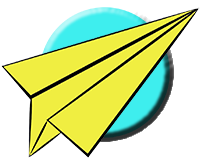Leopard Paper Airplane Folding Instructions
Leopard Paper Airplane Folding Instructions
Instructions
1. Fold the paper exactly in half so the top point hits the bottom point. Unfold after the crease has been made.
2. Rotate the paper around so the crease just created is vertical. Fold the right point in so it hits the center line crease. When folded correctly, the upper right diagonal edge should line up with the center line crease.
3. Fold the left point in so it hits the center line crease. When folded correctly, the upper left diagonal edge should line up with the center line crease.
4. Make a crease to fold the inside lower point of the triangular flap on the right side, out towards the outside edge. The right point of the crease should be at the right corner of the flap and the left point should be about three finger widths down from the nose point.
5. Make a crease to fold the inside lower point, of the triangular flap on the left side, out towards the outside edge. The left point of the crease should be at the left corner of the flap and the right point should be about three figher widths down from teh nose point.
6. Fold the right point in so it hits the inner diagonal edge of the outside triangular flap. When folded correctly, the upper right edge should line up with the inside diagonal edge.
7. Fold the left point in so it hits the inner diagonal edge of the outside triangular flap. When folded correctly, the upper left edge should line up with the inside diagonal edge.
8. Rotate the paper around so the nose is pointing to the left.
9. Make a crease so the right point of the outside triangular flap hits the center line crease. When folded correctly, the edge of the flap which is underneath should line up with the center line crease.
11. Rotate the plane around so the nose is pointing to the right.
12. Make a crease so the left point of the outside triangular flap hits the center line crease. When folded correctly, the edge of the flap which is underneath should line up with the center line crease.
10. Make a crease to fold the flap just created back on top of itself. The right point of the crease should be at the top point and the left point should be at the point on the center line crease formed by the folded over flap. This is not an easy fold so take time to get it right.
13. Make a crease to fold the flap just created back on top of itself. The left point of the crease should be at the upper left point and the right point should be at the point on the center line crease formed by the folded over flaps. Again, take care to get the folds right as this is a difficult fold.
14. Fold the plane in half about the existing center line crease. Be sure to line up the wing flaps for good balance.
15. Rotate the plane around so the nose is pointing to the left and the wing flaps are pointing up.
16. Make a crease to create the first wing flap. The left point of the crease should be at the tip of the nose and the right point should be about two finger widths up the tail
17. Flip the plane over so the first wing flap is underneath and the nose points to the left.
18. Make a crease for the second wing flap. Be sure to line up the wing flaps for good balance.
19. Open up the wing flaps and adjust the wing angles so they are even. Set the dihedral angle flat to slightly up. Some tape on the open part of the wings will reduce drag during flight but is not necessary.
THE THROW This plane requires a soft level throw or at a slight up angle. It will float fairly straight when folded well.
